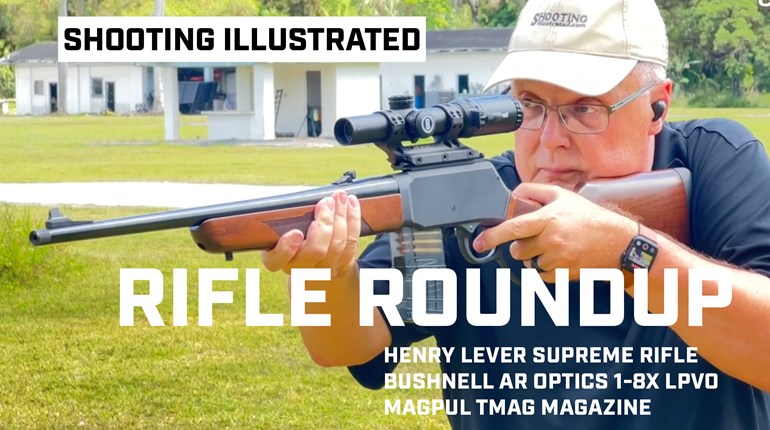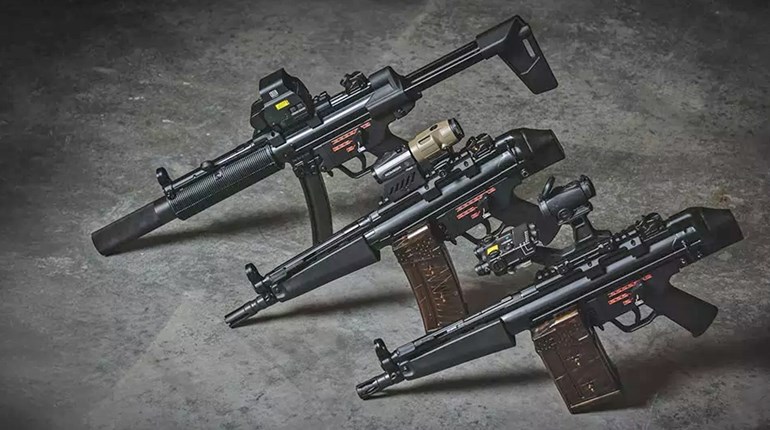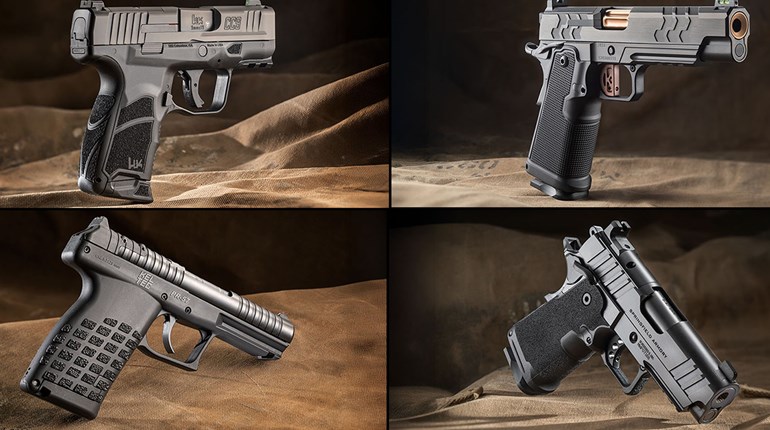
AR pistols have for some time been a unique curiosity. Built on standard AR-15-style frames minus a rifle stock, these purpose-built pistols have the same look and feel of a carbine version, but with a shortened barrel.
They have historically used the standard, direct-gas-impingement operating system and bolt-carrier group. AR pistols have, until now, always had the odd-looking naked buffer tube sticking out of the rear. Get ready for a change.
Rock River PDS
Utilizing its brand-new Piston Driven System (PDS), Rock River Arms has changed the face of the AR pistol. The first thing shooters notice about the company's new 5.56 NATO pistol is the absence of a buffer tube. That fact leads to the next question, "How does it work?"
Not wanting to simply mimic what was already out there, Rock River's engineers set out to design their own piston-operated AR. The creation is the PDS. Essentially a short-stroke piston, the entire operating system is housed in the upper portion of the receiver—including the recoil-spring assembly.
Inside the upper receiver, you'll find a redesigned bolt carrier, but the bolt itself is that of a standard AR-15. Naturally, the gas key and tube are missing. On the bolt, the extractor and ejector are stock AR parts, as is the firing pin.
On the right side of the upper receiver at the gas port, you will find a two-position regulator marked L and S. Quite simply, the L stands for large gas port and the S stands for small. Due to the variances between .223 Rem. and 5.56 NATO ammunition, the regulator is a prudent addition. The small port naturally reduces the amount of burnt propellant gases moving back into the action. If your pistol is not cycling properly on S, switch it over to L to increase gas flow.
Because it is a pistol, the barrel length on this model is just 8 inches. The barrel is made of chrome-moly steel and the rifling is 1:9-inch RH twist. All the steel parts have a Parkerized finish with matching aluminum components.
The pistol is loaded by using an ambidextrous charging handle located at the forward portion of the upper receiver. This mechanism operates independent of the bolt and does not reciprocate back and forth with the bolt carrier during firing. The right and left charging handles are hinged and fold down against the pistol when not in use.
Moving to the lower receiver, you find it is essentially stock with the primary exception of the buffer-tube assembly. Where the buffer tube would reside, Rock River Arms simply plugged the hole with a piece of machined aluminum. There is a Picatinny rail where the stock would be, which enables users to mount a single-point sling adapter.
As for the manual controls—save for the charging handle—they are all standard so there is no need to retrain your muscles. Inside the lower receiver, Rock River Arms has installed its high-quality, single-stage trigger. In my experience, Rock River puts some of the best factory triggers you will find in a stock AR-15, or in this case, an AR pistol.
Regarding the furniture on the PDS, you'll be holding onto this pistol with an injection-molded polymer fore-end. It is flared at the front to prevent your support hand from slipping forward. As for the pistol grip, the company has installed a super-comfortable Hogue grip. This is no pocket pistol and its empty weight is 5 pounds. The overall length is 17.5 inches. Each pistol arrives in a large, padded hard case with a 30-round AR magazine and an owner's manual.
Sights and Optics
With the popularity of red-dot optics, the folks at Rock River Arms made the decision not to ship the pistol with sights. It is expected the user will choose his own. I worked with both iron sights and an EOTech holographic weapon sight.
The iron sights were Folding Battle Sights from Troy Industries. The front-sight assembly has an M4-style quarter-click post and a set of wings protected it from damage.
At the rear was Troy Industries' new DOA sight. DOA stands for DiOptic Aperture. This flip-up sight included a dual aperture. The large peep-style aperture is a diamond shape and is used for closer targets, 300 yards and in. A second aperture flips up and is used more like a normal target sight for greater distances—naturally your effective range with a pistol will be considerably less than with a rifle.
EOTech's XPS3 Holographic Weapon Sight was introduced about a year ago and uses a single CR123 lithium battery that will give you up to 500 hours of run time. The reticle is the company's combination circle/dot with a 65-MOA outer ring and a 1-MOA center dot.
Range Time
The first step of my range testing was to chronograph four separate .223 Rem. loads in various weights and bullet designs. It was early September in Biloxi, MS, and the temperature was a mild 85 degrees Fahrenheit. Humidity was pleasantly low. Average velocities were more than respectable.
Next on my list of things to do was to zero both the iron sights and the EOTech. Fortunately, they were effectively co-witnessed. For accuracy testing, I used the iron sights. A 20-round magazine from Brownells fed the pistol, which allowed me to rest the PDS on my range pack for greater stability.
I used Birchwood Casey Dirty Bird targets so I would be able to see where the rounds impacted. From a distance of 50 yards, I could see the bullet holes clustering tightly together and was excited to record the resulting groups. Despite the variance in bullet weights and designs, every load posted sub-2-inch groups.
After my bench work, I moved to the unimproved range and went to work on silhouette targets using the EOTech. Those familiar with direct-gas-impingement AR's will immediately notice the difference. The pistol definitely has a unique feel. I suppose the best way to describe the recoil inertia is snappy. It almost seems faster than a standard AR. Of course, we are talking about fractions of a second. When shooting an AR-platform firearm, it's a bit strange to feel the recoil inertia or movement up front versus at the rear of the gun.
Parting Thoughts
The PDS from Rock River is a brand-new operating system—one that will need some more field trials before the jury is in. At the moment, preliminary results indicate it's a valuable addition to the AR-styled-firearm market. All of the .223 Rem. ammunition I ran though the pistol cycled without fail.
With the widespread popularity—especially among military and law enforcement personnel—of short-barreled rifles, reliability issues and bolt failures have been an increasing problem. Many engineers hold that the shorter gas tubes in these guns result in dramatically increased pressure, ultimately contributing to malfunctions.
The next big test for the PDS operating system will be to run it suppressed and in selective-fire mode. Of course, that's an entire article unto itself. For now, suffice it to say that Rock River Arms is moving in the right direction.
Is the PDS operating system the wave of the future for AR pistols? Only time will tell.
Manufacturer: Rock River Arms;(866) 980-7625, www.rockriverarms.com
Action Type: Gas-piston-driven,semi-automatic
Caliber: 5.56 NATO
Capacity: 30 rounds
Receiver: 7075-T6 aluminum forging
Barrel Length: 8 inches
Rifling: Six grooves; 1:9-inch RH twist
Sights: None, extended top Picatinny rail for mounting optics
Trigger Pull: 5 pounds, 13 ounces
Overall Length: 17.5 inches
Weight: 5 pounds
Accessories: Hard case, owner's manual
MSRP: $1,335




































